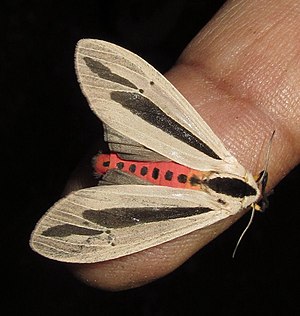Creatonotos gangis
Due to formal or content deficiencies in the quality assurance biology in the section "Insects" for improvement, this article has been entered. This is done in order to bring the quality of the biology articles to an acceptable level. Please help improve this article! Articles that are not significantly improved can be deleted if necessary.
Read the more detailed information in the minimum requirements for biology articles .
Reason: Sources are missing, so an insufficient article - Vincent Malloy ( discussion ) 16:50, Nov. 7, 2017 (CET)
| Creatonotos gangis | ||||||||||||
|---|---|---|---|---|---|---|---|---|---|---|---|---|

Creatonotos gangis |
||||||||||||
| Systematics | ||||||||||||
|
||||||||||||
| Scientific name | ||||||||||||
| Creatonotos gangis | ||||||||||||
| ( Linnaeus , 1763) |
Creatonotos gangis is a butterfly (moth) from the family of the owl butterflies (Noctuidae), which is native to Southeast Asia and Australia . It was developed by Carl Linnaeus in 1763 in his Centuria Insectorum as Phalaena Gangis described .
description
Adults have white hind wings and brown fore wings, each with a dark stripe and a wingspan of about 40 millimeters. The abdomen is red or, less often, yellow. The eggs are yellow and round and are laid in rows of about 50 eggs on the leaves of the food plants. The caterpillars are brown hairy animals with a yellow stripe along their backs that feed on soybeans, rice, and corn.
Males have four large, X-shaped everted scent organs that can exceed the length of the abdomen when inflated. Adult males secrete hydroxydanaidal as a sex pheromone through these olfactory organs . This is absorbed in the caterpillar stage via the pyrrolizidine alkaloids of the host plants. Male animals store up to 400 micrograms of hydroxydanaidal, a strong liver poison. The poison is transferred to the eggs and protects the offspring from eating.
Web links
- Creatonotos gangis (Linnaeus, 1763) in: Coffs Harbor Butterfly House.
- Carl Linnaeus: Centuria Insectorum, Amoenitates Academicae, Volume 6 (1763), S 410-411, No. 82.
- Video of alien-like creature with hairy tentacles and orange body
Individual evidence
- ↑ What on Earth? Freaky Moth with Hairy 'Butt Appendages' Stuns Facebook.
- ↑ Jeffrey B. Harborne: Introduction to Ecological Biochemistry , Gulf Professional Publishing, 1993, ISBN 978-0-12-324686-8 , pp. 71-103.